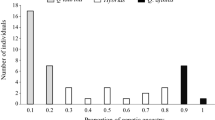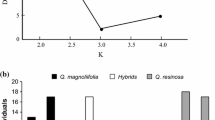Abstract
Both ecological and genetic mechanisms have been proposed to explain patterns of herbivore attack on interspecific plant hybrids, but distinguishing among them can be difficult in natural hybrid zones. We performed a common-garden experiment to evaluate four genetic hypotheses: dominance, additivity, elevated hybrid susceptibility, and elevated hybrid resistance. Censuses and cage experiments were used to compare insect responses to basin big sagebrush (Artemisia tridentata spp. tridentata), mountain big sagebrush (A. t. vaseyana), and their F2 progeny. After two growing seasons, hybrid shrubs resembled mountain big sagenbrush in size, but were more similar to basin big sagebrush in flower production. Censuses of naturally colonizing insects (the gall midge Rhopalomyia obovata, the bagworm moth Apterona helix, and the aphid Obtusicauda coweni) tended to support the dominance hypothesis: if the insect clearly discriminated between the two parents, its frequency on hybrids closely resembled that on one of the parents. Moreover, colonization of hybrids in all three cases suggested a dominance deviation toward the susceptible parent rather than toward the resistant parent. In contrast to the censuses, cage experiments involving two insects supported the hybrid-susceptibility hypothesis; both survival and growth of the grasshopper Melanoplus sanguinipes and growth of the leaf beetle Trirhabda pilosa were higher on hybrid shrubs than on either parent. Because many secondary compounds have been determined to occur at intermediate concentrations in F2 shrubs, dominance for susceptibility may indicate that insects respond to plant traits (e.g., oviposition stimulants and deterrents) in a threshold manner. Mechanisms underlying increased hybrid susceptibility are less clear, but our experimental design makes environmental explanations (e.g., the plant-stress hypothesis) unlikely. Although we eliminated several confounding factors, our results agree with the conclusion from natural hybrid zones that insect responses to hybrid plants are likely to be idiosyncratic; even congeneric species did not respond similarly to hybrid and parental plants.
Similar content being viewed by others
References
Aguilar JM, Boecklen WJ (1992) Patterns of herbivory in the Quercus griseaxQuercus gambelii species complex. Oikos 64:498–504
Beetle AA (1960) A study of sagebrush, the section Tridentatae of Artemisia. Bull Univ Wyoming Expt Stat 368:1–83
Beetle AA, Young A (1965) A third subspecies in the Artemisia tridentata complex. Rhodora 67:405–406
Bishop YMM, Fienberg SE, Holland PW (1975) Discrete multivariate analysis: theory and practice. MIT Pess, Cambridge, Mass., USA
Boecklen WJ, Spellenberg R (1991) Structure of herbivore communities in two oak (Quercus spp.) hybrid zones. Oecologia 85:92–100
Bray RO, Wambolt CL, Kelsey RG (1991) Influence of sagebrush terpenoids on mule deer preference. J Chem Ecol 17:2053–2062
Caldwell MM, Richards JH, Johnson DA, Nowak RS, Dzurec RS (1981) Coping with herbivory: photosynthetic capacity and resource allocation in two semiarid Agropyron bunchgrasses. Oecologia 50:14–24
Christensen K, Whitham TG, Keim P (1995) Herbivory and tree mortality across a pinyon pine hybrid zone. Oecologia 101: 29–36
Fielding DJ, Brusven MA (1992) Food and habitat preferences of Melanoplus sanguinipes and Aulocara elliotti (Orthoptera: Acrididae) on disturbed rangeland in southern Idaho. J Econ Entomol 85:783–788
Floate KD, whitham TG (1993) The ‘hybrid birdge’ hypothesis: host shifting via plant hybrid swarms. Am Nat 141:651–662
Floate KD, Kearsley MJC, Whitham TG (1993) Elevated herbivory in plant hybrid zones: Chrysomela confluens, Populus and phenological sinks. Ecology 74:2056–2065
Floate KD, Whitham TG, Keim P (1994) Morphological versus genetic markers in classifying hybrid plants. Evolution 48: 929–930
Freeman DC, Turner WA, McArthur ED, Graham JH (1991) Characterization of a narrow hybrid zone between two subspecies of big sagebrush (Artemisia tridentata: Asteraceae). Am J Bot 78:805–815
Freeman DC, Graham JH, Byrd DW, McArthur ED, Turner WA (1995) Narrow hybrid zone between two subspecies of big sagebrush, Artemisia tridentata (Asteraceae). III. Developmental instability. Am J Bot 82:1144–1152
Fritz RS, Nichols-Orians CM, Brunsfeld SJ (1994) Interspecific hybridization of plants and resistance to herbivores: hypotheses, genetics, and variable responses in a diverse herbivore community. Oecologia 97:106–117
Gange AC (1995) Aphid performance in an alder (Alnus) hybrid zone. Ecology 76:2074–2083
Goodrich S, McArthur ED, Winward AH (1995) A new combination and a new variety in Artemisia tridentata. Great Basin Nat 45:99–104
Graham JH, Freeman DC, McArthur ED (1995) Narrow hybrid zone between two subspecies of big sagebrush (Artemisia tridentata: Asteraceae). II. Selection gradients and hybrid fitness. Am J Bot 82:709–716
Hamilton KGA (1977) A new Clastoptera from sagebrush (Rhynchota: Homoptera: Cercopidae). J Entomol Soc B C 74:38–41
Hanhimäki S, Senn J, Haukioja E (1994) Performance of insect herbivores on hybridizing trees: the case of the subarctic birches. J Anim Ecol 63:163–175
Hutchings MJ, Booth KD, Waite S (1991) Comparison of survivorship by the logrank test: criticisms and alternatives. Ecology 72:2290–2292
Johnson RH, Lincoln DE (1990) Sagebrush and grasshopper responses to atmospheric carbon dioxide concentration. Oecologia 84:103–110
Jones RG, Gagne RJ, Barr WF (1983) Biology and taxonomy of the Rhopalomyia gall midges (Diptera: Cecidomyiidae) of Artemisia tridentata Nuttall (Compositae) in Idaho. Contrib Am Entomol Inst 21:1–90
Karren JB (1966) A revision of the genus Exema of America, north of Mexico (Chrysomelidae, Coleoptera). Univ Kans Sci Bull 46:647–695
Kelsey RG, Stephens JR, Shafizadeh F (1982) The chemical constituents of sagebrush foliage and their isolation. J Range Manage 35:617–622
Kelsey RG, Wright WE, Sneva F, Winward A, Britton C (1983) The concentration and composition of big sagebrush essential oils from Oregon. Biochem Syst Ecol 11:353–360
Maddox GD, Root RB (1990) Structure of the encounter between goldenrod (Solidago altissima) and its diverse insect fauna. Ecology 71:2115–2124
McArthur ED, Welch BL (1982) Growth rate differences among big sagebrush (Artemisia tridentata) accessions and subspecies. J Range Manage 35:396–401
McArthur ED, Pope CL, Freeman DC (1981) Chromosomal studies of subgenus Tridentatae of Artemisia: evidence for autopolyploidy. Am J Bot 68:589–605
McArthur ED, Welch BL, Sanderson SC (1988) Natural and artificial hybridization between big sagebrush (Artemisia tridentata) subspecies. J Hered 79:268–276
Moorehead JR, Taper ML, Case TJ (1993) Utilization of hybrid oak hosts by a monophagous gall wasp: how little host character is sufficient? Oecologia 95:385–392
Paige KN, Capman WC (1993) The effects of host-plant genotype, hybridization, and environment of gall-aphid attack and survival in cottonwood: the importance of genetic studies and the utility of RFLPs. Evolution 47:36–45
Preszler RW, Boecklen WJ (1994) A three-trophic-level analysis of the effects of plant hybridization on a leaf-mining moth. Oecologia 100:66–73
Price PW (1991) The plant vigor hypothesis and herbivore attack. Oikos 62:244–251
Pringle WL (1960) The effect of a leaf feeding beetle on big sagebrush in British Columbia. J Range Manage 13:139–142
Robinson AG, Halbert SE (1989) Review of Obtusicauda (Homoptera: Aphididae) of America north of Mexico, with a key to species. Can Entomol 121:525–531
Rosentreter R, Kelsey RG (1991) Xeric big sagebrush, a new subspecies in the Artemisia tridentata complex. J Range Manage 44:330–335
SAS (1993) The SAS system for Microsoft Windows, Release 6.10. SAS Institute, Cary, N.C., USA
Shultz LM (1983) Systemiatic and anatomical studies of Artemisia subgenus Tridentatae. PhD dissertation, Claremont University, Claremont, Calif., USA
Siemens DH, Ralston BE, Johnson CD (1994) Alternative seed defence mechanisms in a palo verde (Fabaceae) hybrid zone: effects on bruchid beetle abundance. Ecol Entomol 19:381–390
Sokal RR, Rohlf FJ (1981) Biometry, 2nd edn. Freeman, San Francisco
Southard A, Wilson I, Erickson A (1978) Chemical and physical properties of the soils of the Cache Valley area and the eastern portion of Box Elder County, Utah. Utah Agric Expt Stat Res Rep 31. Utah State University, Logan, Utah, USA
Strauss SY (1994) Levels of herbivory and parasitism in host hybrid zones. Trends Ecol Evol 9:209–214
Weber DJ, Gang DR, Halls SC, Smith BN, McArthur ED (1994) Inheritance of hydrocarbons in subspecific big sagebrush (Artemisia tridentata) hybrids. Biochem Syst Ecol 22:689–697
Welch BL, McArthur ED (1981) Variation of monoterpenoid content among subspecies and accessions of Artemisia tridentata grown in a uniform garden. J Range Manage 34:380–384
Welch BL, McArthur ED (1986a) Wintering mule deer prefernece for 21 accessions of big sagebrush. Great Basin Nat 46:281–286
Welch BL, McArthur ED (1986b) Growth rate of big sagebrush as influenced by accessions, sites, subspecies, and years. In: McArthur ED, Welch BL (eds) Proceedings-symposium on the biology of Artemisia and Chrysothamnus. USDA Forest Service Gen Tech Rept INT-200, Ogden, Utah, pp 342–346
Welch BL, McArthur ED, Rodriguez RL (1987) Variation in utilization of big sagebrush accessions by wintering sheep. J Range Manage 40:113–115
Wheeler AG Jr, Hoebeke ER (1988) Apterona helix (Lepidoptera: Psychidae), a Paleartctic bagworm moth in North America: new distribution records, seasonal history, and host plants. Proc Entomol Soc Wash 90:20–27
Whitham TG (1989) Plant hybrid zones as sinks for pests. Science 244:1490–1493
Whitham TG, Morrow PA, Potts BM (1994) Plant hybrid zones as centers of biodiversity: the herbivore community of two endemic Tasmanian eucalypts. Oecologia 97:481–490
Wilkinson L (1988) SYSTAT: The system for statistics. SYSTAT, Evanston, III., USA
Wilt FM, Geddes JD, Tamma RV, Miller GC, Everett RL (1992) Interspecific variation of phenolic concentrations in persistent leaves among six taxa from subgenus Tridentatae of Artemisia (Asteraceae). Biochem Syst Ecol 20:41–52
Author information
Authors and Affiliations
Corresponding author
Rights and permissions
About this article
Cite this article
Messina, F.J., Richards, J.H. & McArthur, E.D. Variable responses of insects to hybrid versus parental sagebrush in common gardens. Oecologia 107, 513–521 (1996). https://doi.org/10.1007/BF00333943
Received:
Accepted:
Issue Date:
DOI: https://doi.org/10.1007/BF00333943




